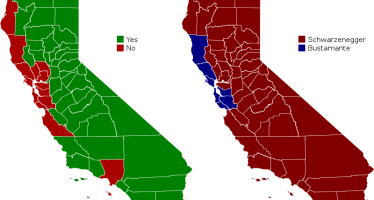Alt Energy Bills Will Inflate Electric Costs
FEB. 7, 2011
By WAYNE LUSVARDI
California’s elite legislators and green power industrialists got together on Feb. 3 in Sacramento to push for new legislation to expand green power mandates from 20 percent to 33 percent by 2020, just as gasoline prices are spiking to pay for the higher cost of food in Egypt and the rest of the Middle East.
You would think that California would take notice of what is happening not only in Egypt but inTexas and New Mexico, both green power states, that suffered rolling blackouts and natural gas outages due to the national cold snap. Texas is home to the largest wind farms in the world. Apparently, green power hasn’t helped Texas, New Mexico or other states through the cold weather gripping the country.
Those who attended the Sacramento meeting also pushed three other bills for clean energy education, incentives for lenders to lower rates on clean energy related loans, and streamlining regulations for building wind and geothermal power plants. No mention was made at the meeting where the money would come from for this package of legislation given that the state is broke. Nor was there any disclosure if the proposed incentives for lenders to make green tech loans meant tax credits for banks that would reduce the amount of taxes that would otherwise go to plug the state budget deficit. In other words, it all sounded good but can California afford all of this?
This new package of legislation was justified on the basis that it would keep the green jobs momentum going. No mention was made that California is still leading the nation in jobs losses despite green jobs.
Tom Stever is the apparent financial engineer behind this proposed bundle of new legislation and attended the Sacramento meeting. Steyer is the CEO of Farallon Investments that is an external fund manager for the CalPERS pension fund. Steyer contributed $5 million to the successful effort to defeat Prop. 23 on the November 2010 ballot that would have suspended AB32 – the California Global Warming Solutions Act.
Steyer manages a portfolio of conventional oil and natural gas energy stocks for the CalPERS pension fund that would stand to reap a windfall if cheap imported coal and hydro power from other states can be blockaded and replaced with expensive green power from in-state power plants.
There is a term in economics that explains why hedge fund managers like Steyer want to push for expanding green power. It is called “rent seeking” (like parasitism in biology). Think of a Monopoly © board game where if you can buy Boardwalk you can soak high rents out of the other players.
These green-power policies could indirectly plug the unfunded gap in CalPERS pension fund from higher electricity prices from California electricity ratepayers. Instead of going directly to the Public Utilities Commission (PUC) or the Federal Energy Regulatory Commission (FERC) for electricity rate increases, advocates for this idea can rig energy markets so that the energy portfolio for CalPERS will siphon money out of electricity ratepayer’s bank accounts via inflated electricity rates that, in turn, will puff up oil and gas stock prices and refill CalPERS pension fund.
This kind of manipulation of the energy market is similar to what got the stock and bond markets to collapse in 2008 after social engineers rigged housing finance markets to siphon monies out of pension and savings accounts and transfer it into mortgages to expand affordable housing to boost family formations and plug the gap in the Social Security Trust Fund. This wealth transfer caused a panic in the financial markets in 2008 that resulted in CalPERS losing about 25 percent of its pension fund portfolio value.
Artificially raising electricity prices so that expensive green power can compete in the energy market is a risky venture given that oil and gasoline prices are concurrently spiking so that Mid-Eastern countries can pay for wheat and other foodstuffs, which has caused the riots in Egypt, Tunisian and Yemen. In 2010, Egypt was compelled to begin importing oil and gas from neighboring nations due to a decline in production of their own oil and gas energy resources. This resulted in less revenue to subsidize wheat and other necessities thus inciting the riots.
Like Egypt, Californians will soon be caught in a pincers between intentionally inflated green electricity prices and higher gasoline prices to pay for the rising cost of food in the Mid-East. The confluence of all these forces could result in another “perfect storm” and energy crisis for California sometime down the road, but probably after 2012 when California’s Green Power Law kicks in.
This is why the Center for Race, Poverty and the Environment, representing California’s migrant and lower income populations, has sued the California Air Resources Board to block the roll out of California’s Energy Cap and Trade Program.
The lawsuit is only likely to delay the start up of California’s cap and trade program. But this is a signal that California’s underclass stands to suffer the most from Green Power. Nonetheless, the Democratic Party is proceeding full speed with Green Power no matter if the timing is not advantageous. The Democratic Party seems more interested in plugging the deficit in the CalPERS pension fund for unions than in helping those at the bottom of the economic ladder or in avoiding raising utility rates on businesses in a recession.
Like Egypt, California is soon likely to have future mass protests, but about electricity rate increases for Green Power instead of food prices. California has an Egyptian (i.e., Third World) energy policy.
Related Articles
Top 10 quotes from the 2003 Gray Davis recall
October 7 marks the 10-year anniversary of the recall of California Gov. Gray Davis. The 2003 recall brought a
CA legislators join vote to end federal shutdown
The 16-day federal government shutdown is over, and America’s borrowing limit has been raised following an 81-19 vote in the
More food stamp cuts coming
Last week, expansions ended to the Supplemental Nutrition Assistance Program (SNAP), better known as the Food Stamp program. Food stamp




